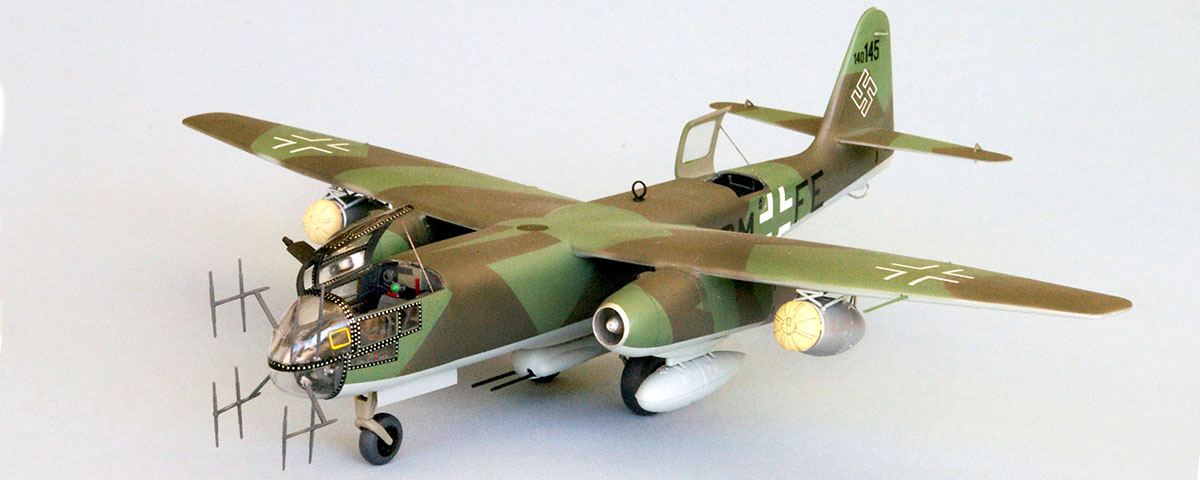Historical records indicate that Germany only built 210 Arado Ar-234 “Blitz” aircraft before World War II came to a close. While most were completed as bomber-reconnaissance versions, a few were produced as radar-equipped night fighters. Revell of Germany and Hasegawa have produced replicas in 1/48th scale of this mostly ignored late-war jet twin.
In the Hasegawa version, the cockpit is made up of more than 20 pieces and is situated in a “glass bubble.” Instructions call for the interior to be painted Schwarzgrau, RLM-66. Masking and painting the interior glass is complicated and difficult; however, a set of vinyl masks from EZ Masks is available from a Canadian source and can be purchased via the Internet. With the interior glass sections painted, apply the kit decals to the instrument panel and side consoles.
When the cockpit is complete, set it aside to dry. Follow the instructions carefully and assemble the two main bubble parts together using white glue (styrene cement will damage clear parts). When it has set solid, carefully slip and glue the competed cockpit parts inside the bubble. This is a tricky maneuver, so take your time and be sure the cockpit fits exactly.
The radar operator’s compartment is RLM-66 with flat black, FS-37038, and Grau, RLM-02, used for the seat and the radar set. Use the kit decal to detail the radar equipment. Glue the competed radar compartment into one side of the fuselage. Tackle the main gear bays next by painting them RLM-02 and then attaching them to a fuselage side.
I used epoxy to cement two ¼-ounce fishing weights to the forward portion of the fuselage so the model would sit correctly on its landing gear. Before cementing the fuselage parts together, insert the horizontal stabilizers through the slots in the tail and glue them into place. The top and bottom wing sections are then cemented together and glued to the fuselage.
Next assemble and paint the dual Junkers Jumo 004B jet engines. The engine pods fit flawlessly, so I held off attaching them until after I painted the underside of the wings.
One of the most difficult tasks in assembling this model is the construction of the suspension racks for the Walter Ri-202 rocket takeoff assist pods. Five very delicate parts hold the units in place under the wings. These rockets were jettisoned after the aircraft reached about 200 feet on takeoff. They should be painted aluminum, with the nose recovery parachutes sprayed light tan. Dry brush the chutes with brown to show wear and dirt.
Check over your basic construction, then sand and fill any imperfections. A coat of primer will highlight any flaws. Camouflage colors used on German aircraft during WWII varied as the conflict progressed. The Arado 234B-2/N night fighter reportedly appeared in two schemes. One featured flat black undersides and Weissblau, RLM-76, topsides with Grauviolet, RLM-75, splotches. Another, which I chose, was found on the aircraft of Captain Josef Bisping, commander of a group in Oranienburg, Germany, in January and February 1945. His aircraft was painted in the standard RLM-76 underside and a two-tone splinter camouflage topside of Braunviolet, RLM-81, and Hellgrün, RLM-83. (Some dispute the RLM-83 color, arguing it should be RLM-82, Dunklegrün.)
With the camouflage painting compete, brush the landing gear legs with RLM-02, the wheels tire black and then attach the undercarriage to the fuselage. The engine pods, with the extended range fuel tanks, are next, followed by the Walter rocket assist units. The kit contains all the markings for Captain Bisping’s B-2/N. Spray a coat of clear gloss to provide a smooth surface for the decals to adhere to.





